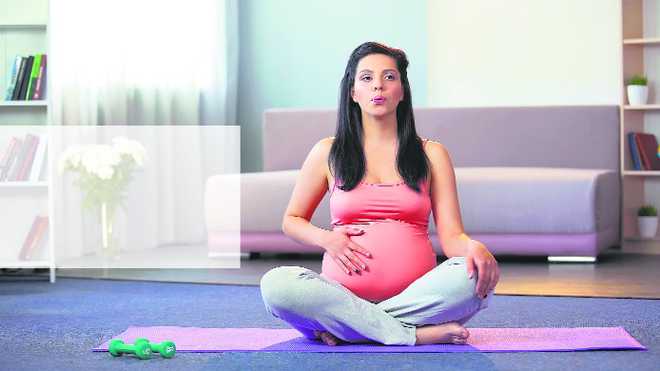Yoga is an ancient scientific system of physical and mental practices. It remains significant even in modern times. From lifestyle problems to natural processes like pregnancy, yoga is beneficial. Many of us erroneously believe that stretching or exercising during pregnancy should be avoided. However, prenatal yoga through simple asanas and breathing and relaxation methods help to alleviate pain during labour and promote a natural birth.
Benefits during and after pregnancy
Yoga can help you prepare your body and mind for labour and the birthing process. It is an effective way to keep your body active and supple during and after pregnancy.
Benefits during pregnancy
Prenatal yoga offers many benefits to expectant mothers and developing babies. Research has shown that prenatal yoga can alleviate stress, reduce anxiety, build up strength, enhance sleep, augment flexibility and bolster muscles vital for childbirth. In addition to these benefits, it can also help in minimising nausea, headaches, breathlessness, etc. Most significantly, prenatal yoga can substantially lowers the risk of premature labour, hypertension and intrauterine growth restriction.
Benefits of prenatal yoga
Breathing: Yoga can help you tailor your breathing to do a range of activities. Yoga prepares you for labour, helping you breathe consciously, relaxing your muscles and channelling your pain through paced pranayamas.
Pelvic floor strengthening: The pelvic floor is a canopy of muscles that line the pelvis. This muscular band plays a critical role within the female reproductive system, supporting a baby all the way through pregnancy. Pregnancy can cause a strain on the pelvic floor, weakening its muscles as the foetus grows. A weak pelvic floor could lead to urinary incontinence, constipation, irritable bowels, reduced libido, painful intercourse, abdominal pain and uterine prolapse. In light of these factors, it is important that these muscles be fortified through scaled exercises during pregnancy. With yoga, this is possible.
Posture: The centre of gravity shifts as pregnancy advances. Luckily, your back and abdominal muscles have you covered, balancing each other out to hold you upright. Sometimes, weak abdominal muscles can cause unnecessary strain on the lumbar region, giving rise to aches and pains. Pregnancy unwittingly expands these abdominal muscles. The chakraasana is a wonderful asana to bolster your abdomen and deepen your core. Prenatal yoga exercises can also pave the way for you to regain your pre-pregnancy body after childbirth.
Feet: As a result of the postural shift that often occurs during pregnancy, the feet are left to support an inordinate amount of weight. The natural movement of the feet may be hampered as a result, leading to swelling, cramping, pain, varicose veins and weight gain. Prenatal yoga can help prevent these problems.
Hips: Much of the baby weight that you gain during pregnancy can hinder your flexibility. Through yoga, you can regain much of your lost flexibility, creating a cushion for the muscles and bones that fringe your hips.
Yoga helps you in dealing with the common problems like morning sickness and mood swings and ensuring smoother and easier delivery, and faster recovery after childbirth. So, if you want to make your pregnancy and childbirth a peaceful and easy journey, you must go for a prenatal yoga class during and after your pregnancy. Look for a prenatal yoga program where you are comfortable with the activities, style, and the yoga class environment. Always remember doing “Lamaze” which is a simple breathing yoga techniques, it always encourages you to be active throughout your pregnancy and increases your sense of wellbeing.
All yoga exercises should be started pre-pregnancy so as to have the best result during pregnancy. Do not start exercise for the first time in the first trimester except the breathing exercises.
Some easyprenatal asanas
Marjaryasana & bitilasana (cat and cow pose): It strengthens the spine and eases back pain.
Virbhadrasana (warrior pose): It is good for entire body. It works the back, chest and hip muscles.
It is a great pose for strengthening lower body as well.
Trikonasana (triangle pose): It eases pregnancy-related digestive disorders. It is better to start this asana 20 weeks and beyond.
Utkatasana (chair pose): It helps in strengthening hips and thighs.
Titli asana (butterfly pose): It is good for perineal muscle strength.
Vajrasan (thunderbolt pose): It helps to improve digestion and prevents constipation.
Tadasan (palm tree pose): It is good for relaxation and helps to loosen the spine.
Prasarita balasana (wide knee child’s pose): It helps in relieving belly weight.
Poses to avoid
- Over-stretching
- Twists especially around the belly
- Jumps
- Weight lifting
- Fast breathing
- Inversions
- Backbending
- Abdominal work





 Driving Naari Programme launched in Chandigarh
Driving Naari Programme launched in Chandigarh






























